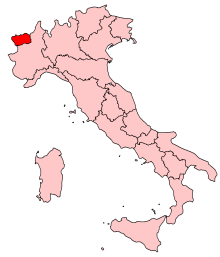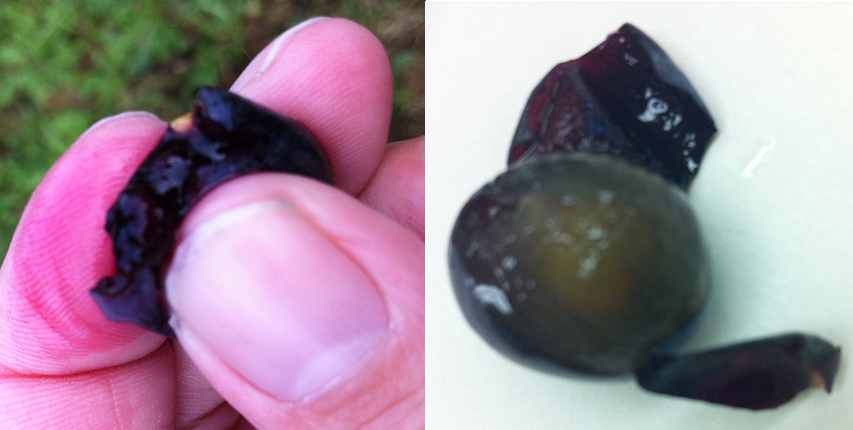|
Roussin De Morgex
Roussin de Morgex (sometimes known as Rossano Rosso in Italy) is an Italian grape variety, native to the western part of Valle d'Aosta in the municipality of Morgex. It is a pink-skinned teinturier grape that produced a light pink juice. Although it may by used as one of the autochthonous varieties allowed in the red DOC wine from the region, Valle d'Aosta Rosso, in 2010 it was not cultivated commercially; according to wine writer Ian D'Agata nobody had made wine from it in 300 years. Since then, small experimental plantings have been made, and a subsequent 20 bottle batch of pink sparkling wine produced by Cave Mont Blanc in 2014 showed sufficient promise to spur further research and planting. Origin Roussin de Morgex belongs to a group of grape varieties geographically isolated in the Alpine regions of Italy and Valais, in Switzerland. DNA analyses suggest that while unrelated to Roussin, it is related to the Prié variety, and more distantly to Rèze, from the Swiss Alps ... [...More Info...] [...Related Items...] OR: [Wikipedia] [Google] [Baidu] |
Valle D'Aosta DOC
The Valle d'Aosta DOC (or Vallée d'Aoste DOC, in French) is an Italian ''denominazione di origine controllata'' located in the Aosta Valley of northwest Italy. Surrounded by the Alps, the Valle d'Aosta is home to the highest elevated vineyards in all of Europe. The principal winemaking region of the Valle d'Aosta is found along the eastern banks of the Dora Baltea ( fr., ''Doire baltée'') river with the city of Aosta serving as the central winemaking location. The region is divided into three main vineyard areas; the upper valley, Valdigne, the central valley (locally ''Valle centrale'' in Italian, ''Vallée centrale'' in French) and the lower valley, (locally ''Bassa valle'' in Italian, ''Basse vallée'' in French). To the south is the winemaking region of Piedmont. The Valle d'Aosta is Italy's smallest winemaking region both in terms of size and production with only about 330,000 cases produced annually in the region and only 36,000 cases produced under the DOC label. Seventy f ... [...More Info...] [...Related Items...] OR: [Wikipedia] [Google] [Baidu] |
Italian Wine
Italian wine is produced in every region of Italy. Italy is the world's largest producer of wine, with an area of under vineyard cultivation, and contributing a 2013–2017 annual average of 48.3 million hl of wine. In 2018 Italy accounted for 19 per cent of global production, ahead of France (17 per cent) and Spain (15 per cent). Italian wine is both exported around the world and popular domestically among Italians, who consume an average of 42 litres per capita, ranking fifth in world wine consumption. The origins of vine-growing and winemaking in Italy has been illuminated by recent research, stretching back even before the Phoenician, Etruscans and Greek settlers, who produced wine in Italy before the Romans planted their own vineyards. The Romans greatly increased Italy's viticultural area using efficient viticultural and winemaking methods. History Vines have been cultivated from the wild ''Vitis vinifera'' grape for millennia in Italy. It was previously believed that ... [...More Info...] [...Related Items...] OR: [Wikipedia] [Google] [Baidu] |
Valle D'Aosta
, Valdostan or Valdotainian it, Valdostano (man) it, Valdostana (woman)french: Valdôtain (man)french: Valdôtaine (woman) , population_note = , population_blank1_title = Official languages , population_blank1 = Italian French , demographics_type1 = Citizenship , demographics1_footnotes = , demographics1_title1 = Italian , demographics1_info1 = 95% , demographics1_title2 = , demographics1_info2 = , demographics1_title3 = , demographics1_info3 = , timezone1 = CET , utc_offset1 = +1 , timezone1_DST = CEST , utc_offset1_DST = +2 , postal_code_type = , postal_code = , area_code_type = ISO 3166 code , area_code = IT-23 , blank_name_sec1 = GDP (nominal) , blank_info_sec1 = €4.9 billion (2018) , blank1_name_sec1 = GDP per capita , blank1_info_sec1 = €38,900 (2018) , blank2_name_sec1 = HDI ... [...More Info...] [...Related Items...] OR: [Wikipedia] [Google] [Baidu] |
Morgex
Morgex ( Valdôtain: ) is a town and ''comune'' in the Aosta Valley region of north-western Italy. High quality white wine is produced in the area, and it is home to the last few plantings of the very rare pink grape, Roussin de Morgex Roussin de Morgex (sometimes known as Rossano Rosso in Italy) is an Italian grape variety, native to the western part of Valle d'Aosta in the municipality of Morgex. It is a pink-skinned teinturier grape that produced a light pink juice. Although .... References Cities and towns in Aosta Valley {{Aosta-geo-stub ... [...More Info...] [...Related Items...] OR: [Wikipedia] [Google] [Baidu] |
Teinturier
Teinturier grapes are grapes whose flesh and juice is red in colour due to anthocyanin pigments accumulating within the pulp of the grape berry itself. In most cases, anthocyanin pigments are confined to the outer skin tissue only, and the squeezed grape juice of most dark-skinned grape varieties is clear. The red color of red wine comes from anthocyanins extracted from the macerated (crushed) skins, over a period of days during the fermentation process. The name teinturier comes from French, meaning to dye or to stain. Wines ''Teinturier'' varieties, while containing a lot of color, usually make special wines, perhaps due to a higher level of tannins, compounds structurally related to the anthocyanins. Many winemakers blend small volumes of ''teinturier'' juices into their wines, to boost the colour, without dramatically impacting the taste. Examples *Alicante Bouschet *Alicante Ganzin * Carolina Black Rose *Chambourcin *Colorino *Dunkelfelder *Gamay de Bouze *Grand Noir d ... [...More Info...] [...Related Items...] OR: [Wikipedia] [Google] [Baidu] |
Denominazione Di Origine Controllata
The following four classifications of wine constitute the Italian system of labelling and legally protecting Italian wine: * ''Denominazione di origine'' (DO, rarely used; ; English: “designation of origin”), * ''Indicazione geografica tipica'' (IGT; ; “indication of geographical typicality”), * ''Denominazione di origine controllata'' (DOC; ; “controlled designation of origin”), and * ''Denominazione di origine controllata e garantita'' (DOCG; ; “controlled and guaranteed designation of origin”). The system was introduced in 1963 shortly after the Treaty of Rome established Italy as a founding member of the European Economic Community, and was modelled on the extant French ''Appellation d'origine contrôlée'' (AOC) laws. It was overhauled in 1992 to match new European Union law on Protected Designation of Origin, introducing the more general ''Denominazione di Origine Protetta'' (DOP) designation for foods and agricultural products, including wines. Further EU ... [...More Info...] [...Related Items...] OR: [Wikipedia] [Google] [Baidu] |
Valais
Valais ( , , ; frp, Valês; german: Wallis ), more formally the Canton of Valais,; german: Kanton Wallis; in other official Swiss languages outside Valais: it, (Canton) Vallese ; rm, (Chantun) Vallais. is one of the cantons of Switzerland, 26 cantons forming the Switzerland, Swiss Confederation. It is composed of thirteen districts and its capital and largest city is Sion, Switzerland, Sion. The flag of the canton is made of thirteen stars representing the districts, on a white-red background. Valais is situated in the southwestern part of Switzerland, the country. It borders the cantons of Canton of Vaud, Vaud and Canton of Bern, Bern to the north, the cantons of Canton of Uri, Uri and Ticino to the east, as well as Italy to the south and France to the west. It is one of the three large southern Alps, Alpine cantons, along with Ticino and the Grisons, which encompass a vast diversity of ecosystems. It is a bilingual canton, French language, French and German language, German ... [...More Info...] [...Related Items...] OR: [Wikipedia] [Google] [Baidu] |
Switzerland
). Swiss law does not designate a ''capital'' as such, but the federal parliament and government are installed in Bern, while other federal institutions, such as the federal courts, are in other cities (Bellinzona, Lausanne, Luzern, Neuchâtel, St. Gallen a.o.). , coordinates = , largest_city = Zürich , official_languages = , englishmotto = "One for all, all for one" , religion_year = 2020 , religion_ref = , religion = , demonym = , german: Schweizer/Schweizerin, french: Suisse/Suissesse, it, svizzero/svizzera or , rm, Svizzer/Svizra , government_type = Federalism, Federal assembly-independent Directorial system, directorial republic with elements of a direct democracy , leader_title1 = Federal Council (Switzerland), Federal Council , leader_name1 = , leader_title2 = , leader_name2 = Walter Thurnherr , legislature = Fe ... [...More Info...] [...Related Items...] OR: [Wikipedia] [Google] [Baidu] |
Rèze
Rèze is a white Swiss wine grape variety that is primarily found around the city of Sierre in the canton of Valais in southwest Switzerland.J. Robinson ''Jancis Robinson's Guide to Wine Grapes'' pg 152 Oxford University Press 1996 Here the variety is used to produce ''vin des glaciers''—a sherry-style wine that utilizes a solera system of wine stored in larch wood or oak barrels that are never fully emptied with newer vintages being added to the barrels containing the older vintages. Despite its historical use in the production of ''vin des glaciers'', its plantings have nonetheless been declining over the last century and now the variety is almost extinction. In the 21st century, DNA profiling determined that Rèze is likely one of the parent varieties to the Piedmont wine grape Cascarolo bianco and the Trentino wine grapes Nosiola and Groppello di Revò.J. Robinson, J. Harding and J. Vouillamoz ''Wine Grapes - A complete guide to 1,368 vine varieties, including their origin ... [...More Info...] [...Related Items...] OR: [Wikipedia] [Google] [Baidu] |
Swiss Alps
The Alpine region of Switzerland, conventionally referred to as the Swiss Alps (german: Schweizer Alpen, french: Alpes suisses, it, Alpi svizzere, rm, Alps svizras), represents a major natural feature of the country and is, along with the Swiss Plateau and the Swiss portion of the Jura Mountains, one of its three main physiographic regions. The Swiss Alps extend over both the Western Alps and the Eastern Alps, encompassing an area sometimes called Central Alps. While the northern ranges from the Bernese Alps to the Appenzell Alps are entirely in Switzerland, the southern ranges from the Mont Blanc massif to the Bernina massif are shared with other countries such as France, Italy, Austria and Liechtenstein. The Swiss Alps comprise almost all the highest mountains of the Alps, such as Dufourspitze (4,634 m), the Dom (4,545 m), the Liskamm (4,527 m), the Weisshorn (4,506 m) and the Matterhorn (4,478 m). The other following major summits can be found in this list of mountains of S ... [...More Info...] [...Related Items...] OR: [Wikipedia] [Google] [Baidu] |






